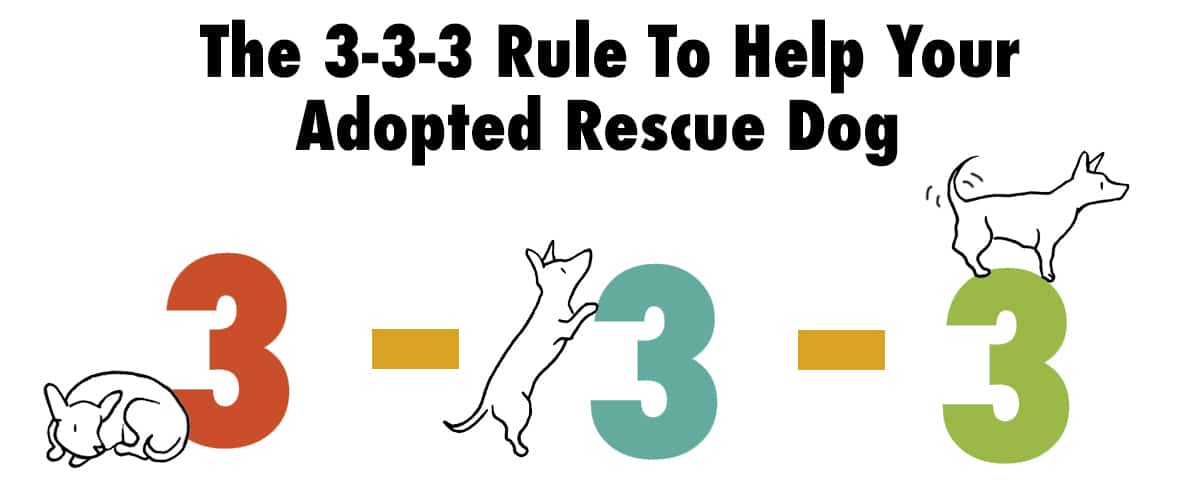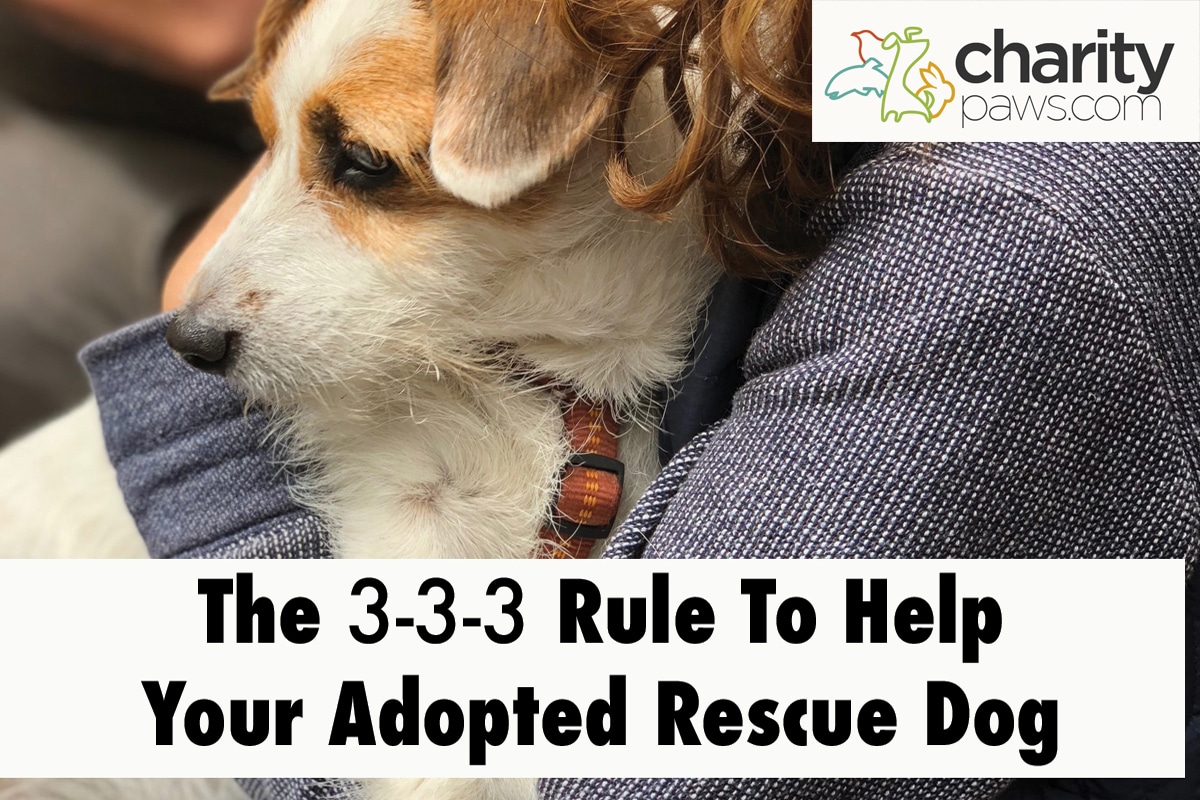If you are adopting a rescue dog and you have done some research on how to get the best start for your life together, chances are you have come by the 3-3-3 rule for adopted dogs.
When adopting a dog, you can’t expect your new best friend to adjust to a new home just like that.
It will take days, weeks, and months for your furry friend to settle in and feel completely comfortable in their new home and surroundings.
During this adjustment period, all dogs go through the same stages.
The pace can vary from one dog to another, but the basic phases are the same.
The rule of three helps you understand this process.
This article will introduce you to everything you need to know about the steps a rescue dog goes through after being adopted and the 3-3-3 rule for dogs.
We will explain what you can expect from your adopted dog after taking them home and most importantly, what you can do to ensure a smooth adaptation period.
What Is The 3-3-3 Rule For Rescue Dogs?

The 3-3-3 rule refers to the first 3 days, first 3 weeks, and first 3 months after bringing your rescue dog home from a shelter.
It will help you understand the three stages your adopted pup goes through when settling into a new home.
Each dog is different, and the time it takes to adapt to a new environment is different for each individual.
Therefore, the pace at which your dog goes through the three stages may vary.
Especially dogs that have dealt with traumatizing experiences like violence or negligence may need more time to feel comfortable and start trusting their new owners.
It may take up to 6 months or more for some dogs to feel entirely at home.
Still, the rule of three will give you general guidelines and an idea of what to expect at each stage.
Before we go deeper into the 3-3-3 rule, we want to remind you that moving to a new home is a massive change for a dog.
Although often things go somewhat smoothly, it’s not uncommon to see all kinds of reactions and behavior during the adjustment period.
Some dogs may have spent weeks or months at a shelter, while others may be used to running free on the streets.
Understandably, moving into a new home and learning the rules and routines will take time.
While puppies often adapt more quickly, older dogs may have a more challenging time settling in.
In addition, your dog’s personality and past experiences play a big part in how well they adapt.
Although each dog is different, the 3-3-3 rule will help you understand what your pup is going through and how you can help them settle in.
The First 3 Days, 3 Weeks, 3 Months – What To Expect
When you bring your rescue dog to its new home, it will not feel comfortable.
Everything around them is new and strange; the sounds, smells, people, things around the house.
Also, they have no idea of what to expect; where and when they will eat, where to go potty, who is the leader of the pack, or who to trust.
Although adopting a dog is a joyous event for both the new owners and the dog, the new member of the family doesn’t know that yet. All they know is they are in a strange place, and they have no idea of what’s going to happen and if they can trust the people around them.
It’s a big change, so no wonder dogs feel overwhelmed and insecure at first.
Slowly, they will begin to feel at home, but it will take time.
The decompression process and becoming comfortable with the new home happens during the first days, weeks, and months.
First 3 Days – The Introductory Period
During the first days after adoption, your pup is likely to
- Feel overwhelmed and stressed
- Not understand what’s happening
- Feel scared and insecure with the new surroundings and unfamiliar people
Moving to a new home is stimulating and exciting, which can become overwhelming, especially for dogs that have spent a longer period in the shelter with limited space and freedom.
While some dogs can become overly excited and have difficulty settling down, others may be scared of all the new people, things, and smells around them and become withdrawn.
Some dogs may shut down and hide somewhere where they feel safe, while others may even stop eating or drinking.
Often, you can witness signs of fear like low ears, cowering, avoiding eye contact, panting, tucking their tail between their hind legs, or hiding.
It is also possible for a dog to act out and test the boundaries during the first couple of days.
Sometimes dogs do this to see who is leading the pack, while other times they just have not been trained and might not know what is expected of them.
It all depends on the dog’s personality and past experiences, which is why it is critical that you talk to the people at the shelter and find out as much as you can about your dog’s personality and past experiences before the adoption.
During the first three days, it’s important to:
- Make your pup feel welcomed and comfortable
- Set up a cozy area where they can retreat to and feel safe
- Keep calm and give clear direction
- Start with the routine
- Give your dog space
First of all, you need to set up a safe area like a crate that is your dog’s private area where they can withdraw to when they feel like it.
It is essential to give your dog time and space to adjust at its own pace during this phase.
Having an area just for themselves where they can control if they want to socialize or not will do just that.
Also, keep kids and other pets away from this safe area so that your newly adopted dog can avoid anything too stressful if it wants to.
During the first few days, you should make your pup feel welcome by talking to them in a friendly, calm, and encouraging tone.
Show them they are welcome, but let them come to you.
It’s good to have toys and treats at hand, but don’t force them to socialize as they may feel overwhelmed.
Dogs usually feel stressed and unconfident during this phase, you should gently start with your everyday routines and schedule as soon as possible because it will help your new family member learn what they can expect to happen during each day.
If you wait too long to set the rules, your dog will have a harder time understanding what the house rules are.
Remember that during this adjustment period, it’s better to bond with your new friend and avoid situations that may overwhelm them.
Although you may be keen to introduce your new pet to your family and friends, restrict visitors and plan on taking it easy for the first few days.
First 3 Weeks – Settling In
During the first three weeks, your adopted rescue dog will
- Settle in and slowly start to feel more comfortable
- Start to understand the routines and rules
- Slowly begin to trust you
- Realize they have come to stay
- Show their true personality more
At this stage, your dog will slowly become more and more comfortable with you.
They start to realize this is their new home permanently and become more secure and confident with the people and pets around them.
During the first three weeks, you will also start to see your dog’s true personality more as they let their guard down.
Becoming more comfortable in a new home is a positive thing as you start to learn about your rescue’s character and what they like or dislike.
However, you may also run into behavioral problems as you start to see your dog’s personality more.
When they begin to feel more secure and confident, adopted dogs may also start to challenge your authority and engage in unwanted behavior.
During the first three weeks, you should:
- Set boundaries
- Implement schedules and routines
- Introduce other pets and family members
- Start training
Although you may feel like you just want to pamper your pup during the first weeks after adoption and start setting the rules later on, consistency and setting clear boundaries from the get-go will actually make your dog feel more at ease.
You may feel sorry for your rescue dog because they have had a rough past, but you shouldn’t let them get away with things and be consistent with the rules of your home.
The first three weeks are roughly the time period when you and your new furry friend get to know each other and settle into a daily routine. You can help your rescue adjust to its new home by setting boundaries and sticking to a predictable daily schedule.
Letting your pup know what is expected from them helps them adjust, settle in, and start trusting you.
At this point, you can also start training.
Not only is it a good way for you to bond with your new pet, but it also helps you teach skills that are needed to live happily together.
Of course, you should not expect too much from your rescue from day one, but postponing training is not a good idea either.
Once those bad habits settle in, they are much harder to unlearn.
First Three Months – Bonding Time
Usually, during the first three months, a rescue dog:
- Becomes fully comfortable with their new home
- Starts feeling completely safe
After about three months, adopted dogs have usually settled in, learned the routines, and started to feel safe with their new owners.
To help you and your pet achieve this, what you can do during those first months is to:
- Bond and build trust
- Stick to the routine
- Make your dog feel safe
Training, playing, and spending time with your dog are great ways to build that bond between the two of you and help build trust. Still, in order to feel safe and comfortable with their owner, dogs also need clear rules and routines.
During the first months, you’re creating that sense of security by not only petting and playing with your pup but also providing them with a consistent daily routine so they can feel safe.

Bottomline – Phases Of A Rescue Dog
By adopting a rescue, you are doing an amazing thing by giving an abandoned dog a loving home.
While everything in your home is familiar to you and you are excited to bond and start having fun with your new friend, the dog you have just adopted is going through a big life change and needs time to process everything.
Although each dog is different and will react to being adopted in their own unique way, the rule of 3 for dogs gives owners general guidelines on the milestones their rescue dog will go through during the first days, weeks, and months.
With the rule of three, you get an idea of what to expect during the first 3 days, 3 weeks, and 3 months.
Knowing what’s ahead will enable you to be prepared and make the adjustment period as easy as possible for you and the newest addition to your family.
We wish you and your new best friend a happy life together.
As a reminder, we have gathered some essential guidelines to follow when bringing home a rescue dog:
Be prepared
Adopting a dog begins before you even bring your rescue home.
You need to make sure you have all the necessities such as dog food, food bowls, leash, and toys.
You should also provide your pup with a quiet area like a crate which will be their safe space while adjusting to their new home.
Dog-proof your home
Walk around your home and make sure it is dog-proofed before bringing in a dog.
Things like trash, household chemicals, batteries, some foods, or kids’ toys can be hazardous for dogs and should be put away.
If you have a yard, make sure the fence is secure and no harmful plants are growing in your garden.
Have a walk outside before entering your home
When you actually bring your adopted dog home, take a long walk before taking them inside.
Doing this will drain extra energy and let them have a sniff of their new surroundings first.
After a walk, your dog will feel calmer entering the house.
Take a tour of the house
Don’t take off the leash just yet.
First, take a tour of the house with your furry friend on the leash.
Not letting them go free sends a message that they are not the leader of the pack, and you are the one in control.
In addition to keeping the leash on, you should make sure to enter and leave each room first, including the patio and backyard.
This also sends your dog the message that you’re the authority in this house.
Stay calm
Because your dog is probably quite overstimulated by the new surroundings, do not create more stimulation by petting or talking to them.
Instead, avoid eye contact and remain quiet and calm while you have a look around the house.
Limit the number of visitors during the first days
The first few days will be extremely stressful for your dog, and they will likely feel overwhelmed by everything that is new to them.
Try not to add to their stress by inviting people over. Instead, take it easy for a few days and spend some quiet time getting to know each other.
Establish routines and boundaries
Although you may feel like you should give your furry buddy some time to settle in before starting with a routine, setting the boundaries and sticking to a predictable daily schedule is actually what helps dogs start to trust the people around them.
Therefore, it’s essential to gently begin implementing routines from day one.
Don’t leave the dog and kids alone
Always remember that you should not leave a dog alone with kids before you know how they react to kids, and you can trust them completely.
Moving to a new home is stressful, and kids may add to this stress making your dog’s behavior unpredictable.

